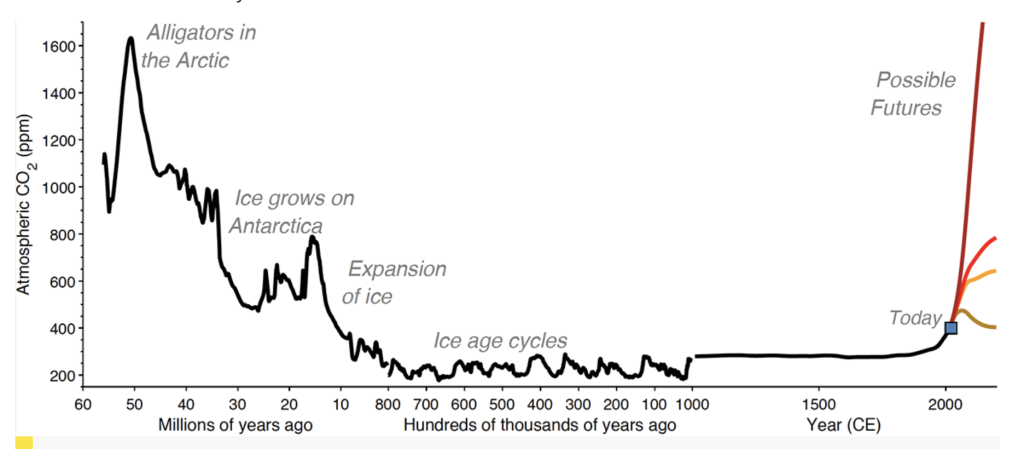Origins of Humans and the Anthropocene
Callan Bentley, Karen Layou, Russ Kohrs, Shelley Jaye, Matt Affolter, and Brian Ricketts and Charlene Estrada
No study of evolution has been more studied than human evolution. Hominids, the name for human-like primates, started in eastern Africa several million years ago.

The first critical event in this story is an environmental change from jungle to more of a savanna, probably caused by changes in Indian Ocean circulation. While bipedalism is known to have evolved before this shift, it is generally believed that our bipedal ancestors (like Australopithecus) had an advantage by covering ground more easily in a more open environment compared to their non-bipedal evolutionary cousins. There is also a growing body of evidence, including the famous “Lucy” fossil of an Australopithecine, that our early ancestors lived in trees.
Arboreal animals usually demand a high intelligence to navigate through a three-dimensional world. From this lineage, humans evolved, using endurance running to acquire more resources and possibly even hunt. This can explain many uniquely human features, from our long legs, strong Achilles, lack of lower gut protection, and our wide range of running efficiencies.

Now that the hands are freed up, the next big step is a large brain. There have been arguments from a switch to more meat-eating, cooking with fire, tool use, and even the construct of society itself to explain this increase in brain size. Regardless, this increased cognitive power allowed humans to reign as their ancestors moved out of Africa and explored the world, ultimately entering the Americas through land bridges like the Bering Land Bridge. The details of this worldwide migration and the different branches of the hominid evolutionary tree are very complex and best reserved for their course.
Anthropocene and Extinction

Humans have influenced the Earth, its ecosystems, and climate. Yet, human activity cannot explain all of the changes that have occurred in the recent past. The start of the Quaternary period, the last and current period of the Cenozoic, is marked by the start of our current ice age 2.58 million years ago. Ice sheets advanced and retreated during this period, most likely due to Milankovitch cycles, which are natural shifts in the Earth’s climate due to the Earth’s eccentric orbit around the Sun and tilt. Miniature temperate or colder periods within overall warm or ice ages occur due to a Milankovitch cycle every 23,000 years.
At this time of the Ice Age, various cold-adapted megafauna emerged (like giant sloths, saber-tooth cats, and woolly mammoths), and most of them went extinct as the Earth warmed from the most recent glacial maximum. A long-standing debate is over the cause of these and other extinctions. Is climate warming to blame, or were they caused by humans? Certainly, we know of the recent human extinction of animals like the dodo or passenger pigeon. Can we connect modern extinctions to extinctions in the recent past? If so, there are several ideas as to how this happened. Possibly the most widely accepted and oldest is the hunting/overkill hypothesis. The idea behind this hypothesis is that humans hunted large herbivores for food. Carnivores could not find food, and human arrival times in locations are often tied to increased extinction rates.

Modern human impact on the environment and the Earth is unquestioned. Many scientists are starting to suggest that the rise of human civilization ended and/or replaced the Holocene epoch and defined a new geologic time interval: the Anthropocene. Evidence for this change includes extinctions, increased tritium (hydrogen with two neutrons) due to nuclear testing, rising pollutants like carbon dioxide, increased warming of the climate, more than 200 never-before-seen mineral species that have occurred only in this epoch, materials such as plastic and metals which will be long lasting ” fossils ” in the geologic record, and large amounts of earthen material moved.

The biggest scientific debate on this topic is the starting point. Some say that humans’ invention of agriculture would be recognized in geologic strata, which should be the starting point, around 12,000 years ago. Others link the start of the industrial revolution and the subsequent addition of vast amounts of carbon dioxide to the atmosphere. Either way, the idea is that alien geologists visiting Earth in the distant future would easily recognize the impact of humans on the Earth as the beginning of a new geologic period.

